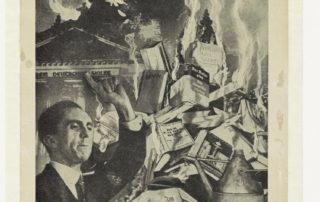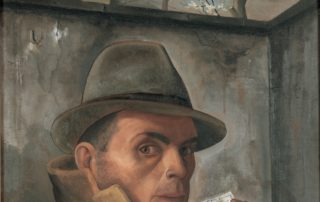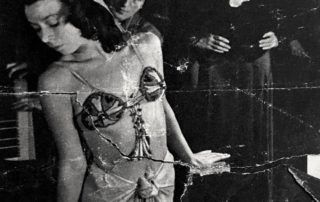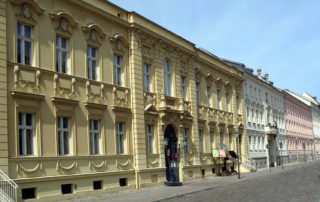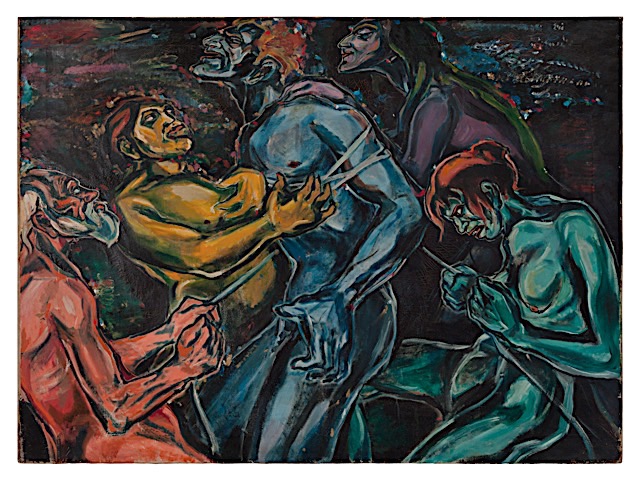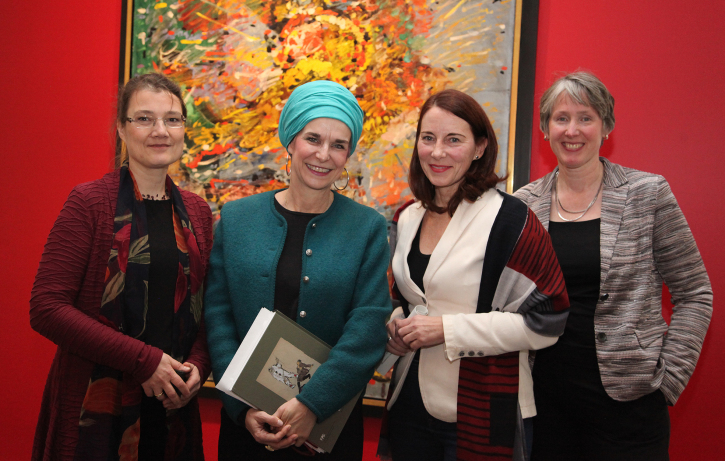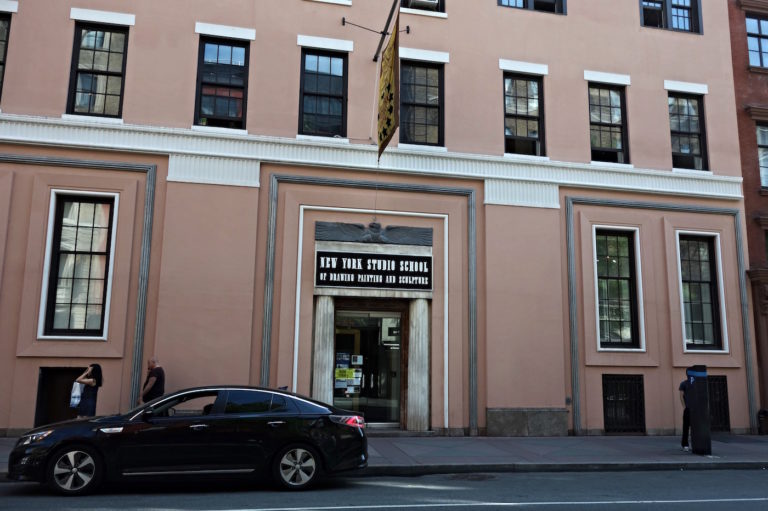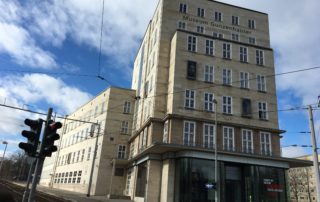Rachel Stern2020-11-04T15:01:37-05:00September 17th, 2020|Events, Lectures, Past Events|
WATCH THE RECORDING OF THIS EVENT HERE. Lecture featuring Rosa von der Schulenburg, Head of the Art Collection of the Academy of Arts in Berlin Moderated by Rachel Stern, Executive Director of the Fritz Ascher Society in New York John Heartfield (1891-1968) was a German visual artist who pioneered the use of art as a political weapon. This presentation starts with preliminary remarks about John Heartfield’s bequest in the Akademie der Künste in Berlin and shows how it is accessible nowadays. A short introduction of how all began follows, showing the background of the birth of Heartfield’s political photo-montages (World War I, Dada, Communist Party, Willi Münzenberg’s Die Arbeiter-Illustrierte-Zeitung in short AIZ), glances at Heartfield’s first exile stage in Prague and then focuses on [...]
Elizabeth Berkowitz2020-10-07T15:08:59-04:00September 16th, 2020|Lectures|
WATCH THE RECORDING OF THIS EVENT HERE. Lecture featuring Anne Sibylle Schwetter, Curator of the Felix Nussbaum Collection in the Felix Nussbaum House in the Osnabrück Museum Quarter, Osnabrück Moderated by Rachel Stern, Executive Director of the Fritz Ascher Society in New York The German-Jewish artist Felix Nussbaum (1904 Osnabrück - 1944 Auschwitz) started a promising career in Berlin around 1930, which ended abruptly when the National Socialists came to power in 1933. Years in exile in Italy and Belgium followed. In 1942 Nussbaum went into hiding in Brussels. The artist's last paintings were created here from June 1943 until shortly before his arrest in June 1944. A little later he was murdered in Auschwitz. Like hardly any other painter [...]
Elizabeth Berkowitz2020-09-16T19:55:58-04:00September 16th, 2020|Lectures|
View a recording of this event HERE. EXCLUSIVE: Watch Annette von Wangenheim's German language documentary film "Tanz unterm Hakenkreuz" from 2003 HERE. Big thanks to Annette von Wangenheim and Sabine Rollberg for making this possible! Gyp Schlicht speaks at 38:02 min. Lecture featuring Sabine Rollberg, Professor Emeritus of Documentary Film at the Academy of Media Arts in Cologne and former ARTE Representative and ARTE Commissioning Editor for WDR Moderated by Rachel Stern, Executive Director of the Fritz Ascher Society in New York In times of Nazi Germany, becoming an artist was not the typical career path for women. The „deutsche Frau“ was supposed to represent the “good housewife”, as a mother of many children, not wearing make-up and fancy dresses. The Nazis were refuting [...]
Rachel Stern2020-10-07T15:06:33-04:00August 31st, 2020|Events, Past Events|
WATCH THE RECORDING OF THIS EVENT HERE. Lecture featuring Anne Sibylle Schwetter, Curator of the Felix Nussbaum Collection in the Felix Nussbaum House in the Osnabrück Museum Quarter, Osnabrück Moderated by Rachel Stern, Executive Director of the Fritz Ascher Society in New York The German-Jewish artist Felix Nussbaum (1904 Osnabrück - 1944 Auschwitz) started a promising career in Berlin around 1930, which ended abruptly when the National Socialists came to power in 1933. Years in exile in Italy and Belgium followed. In 1942 Nussbaum went into hiding in Brussels. The artist's last paintings were created here from June 1943 until shortly before his arrest in June 1944. A little later he was murdered in Auschwitz. Like hardly any other painter [...]
Rachel Stern2020-09-25T07:28:27-04:00August 19th, 2020|Events, Lectures, Past Events|
View a recording this event HERE EXCLUSIVE: Watch Annette von Wangenheim's German language documentary film "Tanz unterm Hakenkreuz" from 2003 HERE. Big thanks to Annette von Wangenheim and Sabine Rollberg for making this possible! Gyp Schlicht speaks at 38:02 min. Lecture featuring Sabine Rollberg, Professor Emeritus of Documentary Film at the Academy of Media Arts in Cologne and former ARTE Representative and ARTE Commissioning Editor for WDR Moderated by Rachel Stern, Executive Director of the Fritz Ascher Society in New York In times of Nazi Germany, becoming an artist was not the typical career path for women. The „deutsche Frau“ was supposed to represent the “good housewife”, as a mother of many children, not wearing make-up and fancy dresses. The Nazis were refuting what [...]
Rachel Stern2020-03-03T07:55:35-05:00August 10th, 2019|Events, Past Events|
ZWISCHEN UTOPIE UND EXIL ARCHITEKTUR, MALEREI UND FILM IM POTSDAM UM 1930 Eine musikalische Zeitreise mit dem Bus in drei Etappen Auf dieser Bustour wird das Potsdam am Ende der Weimarer Republik wieder lebendig. Lassen Sie sich überraschen von der Vielfalt der modernen Architektur und den faszinierenden Kunstwerken jener Zeit, oft gespiegelt in den wechselvollen Lebenswegen ihrer Schöpfer. Zum Abschluss der Exkursion sind im selten zugänglichen Studio des Filmorchester Babelsberg die großen Hits der UFA-Zeit ebenso zu erleben wie die spannenden Geschichten ihrer Entstehung. 10.30 Uhr Musikalischer Auftakt im Nikolaisaal Matthew Rubenstein, Klavier 11.00 Uhr Erste Etappe Die Architektur der Potsdamer Moderne (Rundfahrt mit Stopps u.a. am Luftschiffhafen) Referentin: Prof. Karin Flegel, Urania Potsdam 12.30 Uhr Intermezzo: Mittagessen im Kongresshotel [...]
Rachel Stern2018-12-04T11:57:56-05:00December 27th, 2017|Select Press Coverage|
Fritz-Ascher-Retrospektive „Leben ist Glühn“ Die Wiederentdeckung des Expressionisten Fritz Ascher: eine Doppelausstellung in der Villa Oppenheim und im Potsdam Museum. by Elke Linda Buchholz Einen so vollständig vergessenen Künstler zurückzuholen in die Aufmerksamkeit, braucht Kraft, Geduld und kreative Energie. Vor 30 Jahren stieß die deutsch-amerikanische Kuratorin Rachel Stern bei einem Sammler auf Arbeiten von Fritz Ascher. Sie hatte noch nie von ihm gehört. Jetzt ist sie als quasi weltweit einzige Expertin für den 1893 geborenen Maler wieder zurück in der Stadt, wo auch er einst gelebt und gearbeitet hat. Hier bei Max Liebermann holte der junge Wilde sich als 16-Jähriger nach abgebrochener Schule die höheren Weihen einer Empfehlung an die Königsberger Kunstakademie und startete zwischen Secessionisten und Expressionisten seine Karriere. [...]
Rachel Stern2018-12-04T12:05:52-05:00December 26th, 2017|Select Press Coverage|
Der vergessene Expressionist Das Potsdam-Museum zeigt Werke des von den Nazis verfolgten Malers Fritz Ascher by Mathias Richter Sie gehören zur sogenannten verlorenen Generation. Künstler wie Gertrude Sandmann, Magda Langenstrass-Uhlig oder Eric Isenburger. Sie hatten Anfang der 30er Jahre grosse Ambitionen und wahrscheinlich eine grosse Karriere vor sich. Doch mit dem Machtantritt von Adolf Hitler erhielten sie Berufsverbot, wurden verfolgt, ihre Werke als "entartete Kunst" verfemt. Wer die Nazi-Zeit überlebte war vergessen und stand vor dem Nichts. Einer der Angehörigen dieser verlorenen Generation ist Fritz Ascher. Das Potsdam-Museum widmet dem radikalen Berliner Expressionisten in Kooperation mit der Villa Oppenheim in Berlin-Charlottenburg von Sonntag an eine Sonderausstellung. 80 Gemälde und Grafiken sind in den beiden Museen zu sehen, davon etwa 50 [...]
Rachel Stern2018-12-04T12:14:23-05:00December 22nd, 2017|Newsletter|
Dear Friends, I am humbled and honored to have received the Lea and Hans Grundig Prize for my work about Fritz Ascher. Right on time for his 125th birthday, the Fritz Ascher retrospective is now open in Berlin and Potsdam, the two places where the artist lived and worked. Museum Charlottenburg-Wilmersdorf in der Villa Oppenheim in Berlin exhibits an overview of the artist’s creative development, with a focus on works that relate to Berlin. We see his sketch of the artist Max Liebermann as well as his love for music and performance in Weimar Republic paintings like “Beethoven” and “Bajazzo and Artists”. After surviving the Nazi terror regime in hiding in the Berlin Grunewald neighborhood, he painted these works over [...]
Rachel Stern2018-12-04T12:15:18-05:00December 21st, 2017|Newsletter|
Dear Friends, Today I am excited to share with you some photos of last week’s opening of “Beauteous Strivings: Fritz Ascher, Works on Paper”, which is on view at the New York Studio School daily 10:00am-6:00pm until December 3 (website link). In this exhibition, “powerful emotions seem to lurk just beneath the apparent directness and economy of the tree and flower paintings” of the 1950s and 1960s, observes curator Karen Wilkin in the catalogue that accompanies the exhibition. She continues: “A sense of near-obsession, of ferocious concentration, of focus that excluded everything else, was palpable, made visible in the traces of his rapidly moving hand, driving across the paper, making loops and whorls, and then abruptly changing direction. At the [...]
Rachel Stern2018-12-04T12:36:20-05:00February 28th, 2017|Newsletter|
Dear Friends, Thank you for supporting us with your interest in our work, reading our newsletters and publications and/or visiting our exhibitions, and - last not least - supporting our work financially. 2016 was the first year that our work started showing, with the participation in the exhibition Verfahren. "Wiedergutmachung" im geteilten Berlin / »Making Amends« Compensation and Restitution Cases in Divided Berlin at Aktives Museum Berlin (October 9, 2015 - January 14, 2016) and Landgericht Berlin/Amtsgericht Mitte, Berlin (September 29 - November 18, 2016) and the long anticipated first ever retrospective with its comprehensive catalogue (link) "Leben ist Glühn" Der Expressionist Fritz Ascher / “To Live is to Blaze with Passion" The Expressionist Fritz Ascher at the Felix-Nussbaum-Haus Osnabrück [...]
Rachel Stern2018-12-03T16:21:23-05:00January 12th, 2017|Exhibitions, Past Exhibitions|
The worldwide first Fritz Ascher Retrospective is on view at the Kunstsammlungen Chemnitz - MUSEUM GUNZENHAUSER from March 5 to June 18, 2017. (website link) The main focus of the presentation at the Kunstsammlungen Chemnitz - MUSEUM GUNZENHAUSER is on the artist's important early masterworks like "Golgatha" (1915), "Bajazzo and Artists" (ca. 1916) and "The Tortured" (ca. 1916). For the first time ever, Fritz Ascher’s “Golem” from the collection of the Jewish Museum Berlin will here be reunited with other works the artist created between 1913 and 1933. The Kunstsammlungen Chemnitz is home to an important collection of German Expressionism, dominated by artwork of the locally founded Expressionist group Brücke and especially Karl Schmidt-Rottluff, who grew up in Chemnitz, along [...]


